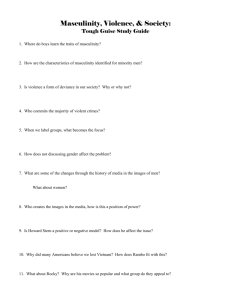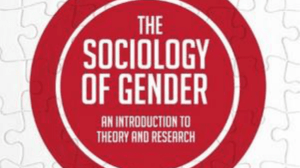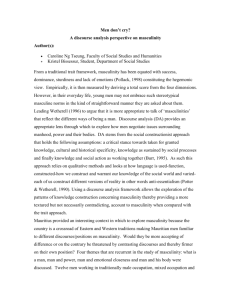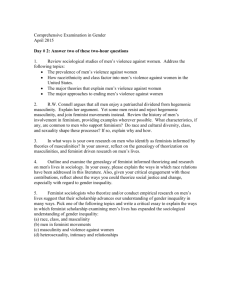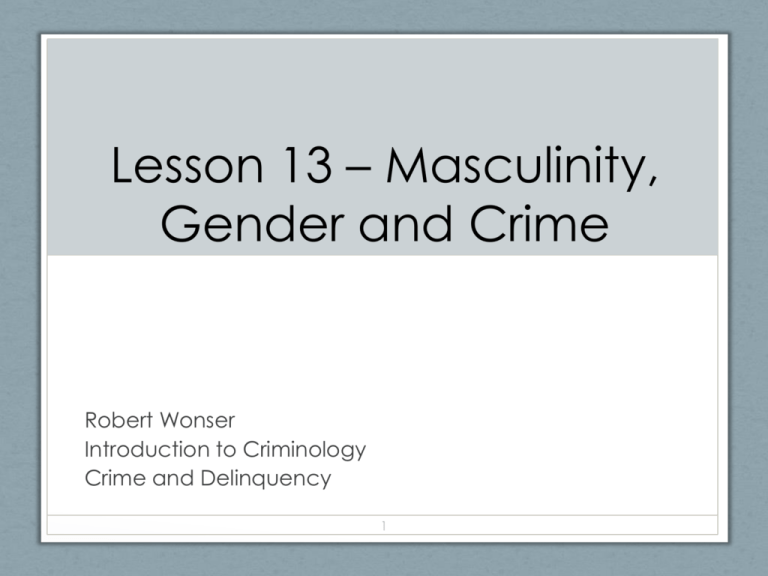
Lesson 13 – Masculinity,
Gender and Crime
Robert Wonser
Introduction to Criminology
Crime and Delinquency
1
What Does it Mean to be a
Man?
• Masculinity, like femininity is socially
constructed and not simply ‘natural.’
• It is a product of socialization, not
testosterone.
• It is a learned behavior.
• What is involved with being a man?
Or to be masculine?
2
What do We think about ourselves?
Ask Google
3
Masculinity as Opposite of
Femininity
4
• Masculinity requires that boys and men
confront violence and be skilled in the
use of violence in those confrontations.
• Most boys and men, of course, are not
accomplished fighters and they are
victimized by those who are.
• Violence against men and boys by other
men and boys is often sexualized.
5
Masculinity in Crisis
• Masculinity is a performance
• One aspect of the performance
of masculinity is being tough
and/or violent (or at least willing
to be)
• Tough Guise
6
Rape Culture
• Another aspect
of maleness,
sexuality and
dominance.
• Rapists as
hyperconformists
to rape culture
7
8
9
10
11
12
13
State Violence Against Men
• The fight to stop domestic violence required
changes in the criminal justice system making it
more cognizant of violence against women and
capable of protecting women.
• The criminal justice system also needs alteration
to prevent it from perpetrating violence against
men in the form of prison system.
• The U.S. has the largest proportion of
incarcerated people.
• Prisons have been a booming business in the past
few decades.
• Most prisoners are men, and most of them are
Latino and African American men.
14
Prison Rape
15
15
Sexual Violence in Men’s Prisons
• Sexual violence is prevalent in
men’s prisons.
• Prison rape is an aspect of “doing
gender” where men are required
to “act like women” as part of
their degradation and
subordination.
16
Sexual Violence in Men’s Prisons
• In men’s penitentiaries, for 2008, the
government had previously tallied 935
confirmed instances of sexual abuse.
After asking around, and performing
some calculations, the Justice
Department came up with a new
number: 216,000. That's 216,000 victims,
not instances.
17
Case in Point
• Milford, Connecticut, Chris Plaskon asked Maren
Sanchez to attend prom with him at the end of the year
at Jonathan Law High School. They’d known each
other since 6th grade. Maren said no. Witnesses told
authorities she declined and told Chris she would be
attending the dance with her boyfriend (here). Chris
knew Maren had a boyfriend and, likely, that she’d be
attending with him. After being turned down, Chris
threw his hands around Maren’s throat, pushed her
down a set of stairs, and cut and stabbed her with a
kitchen knife he’d brought to school that day. It was
April 25, 2014. Maren got to school just a bit after 7:00
that day and before 8:00, she was dead.
18
Psychologically Disturbed?
• Jackson Katz tells us that we need to think about these
tragedies as contemporary forms of masculinity.
• When young men have their masculinity sullied,
threatened or denied, they respond by reclaiming
masculinity through a highly recognizable masculine
practice: violence.
• When events like this happen, it’s easy to paint the
young men who perpetuate these crimes as
psychologically disturbed, as—importantly—unlike the
rest of us.
• But, stories like Chris Plaskon follow what has become
a predictable pattern.
19
Adolescent Masculinity, Homophobia, and
Violence: Random School Shootings, 1982-2001
• Since 1982, there have been 28 cases of random
school shootings in American high schools and middle
schools.
• Kimmel and Mahler find:
• (a) that the shootings were not a national problem
but a series of local problems that occurred in “red
states” or counties (places that voted Republican in
the 2000 election);
• (b) that most of the boys who opened fire were
mercilessly and routinely teased and bullied and that
their violence was retaliatory against the threats to
manhood;
20
Kimmel and Mahler find:
• (c) that White boys in particular
might be more likely than African
American boys to randomly open
fire; and
• (d) that the specific content of the
teasing and bullying is homophobia.
• A link between adolescent
masculinity, homophobia, and
violence is proposed.
21
Social Identity Threat
• When you threaten someone’s social identity,
and they care, they respond by overdemonstrating qualities that illustrate
membership in that identity.
• Michael Kimmel writes about a classic example:
• “I have a standing bet with a friend that I can
walk onto any playground in America where 6
year-old boys are happily playing and by asking
one question, I can provoke a fight. That
question is simple: “Who’s a sissy around here?””
22
Masculinity Threat
• By asking the question, Kimmel is inviting
someone’s masculinity to be threatened
and assuming that this will require someone
to demonstrate their masculinity in
dramatic fashion. Sociologists have a
name for this phenomenon: masculinity
threat.
• New research relying on experimental
designs suggests there’s a lot more to these
claims than we might have thought.
23
• Christin Munsch and Robb Willer conducted an
experiment to see whether gender identity threats
might affect perceptions of sexual coercion.
• Their study clearly showed that when college-aged
men’s masculinity is threatened, they are much
more likely to espouse attitudes supportive of
sexual assault or coercion.
• In a nutshell, men who might feel they have to
demonstrate their masculinity are less likely to see
sexual coercion as sexually coercive and much
more likely to blame the victim (a woman) in the
scenario.
24
Masculine Overcompensation
Thesis
• The masculine overcompensation thesis asserts that men
react to masculinity threats with extreme demonstrations
of masculinity.
• In study 1, men and women were randomly given
feedback suggesting they were either masculine or
feminine. Women showed no effects when told they
were masculine; however, men given feedback
suggesting they were feminine expressed more support
for war, homophobic attitudes, and interest in
purchasing an SUV.
• Study 2 found that threatened men expressed greater
support for, and desire to advance in, dominance
25
hierarchies.
Masculine Overcompensation
Thesis
• Study 3 showed in a large-scale survey on a diverse
sample that men who reported that social changes
threatened the status of men also reported more
homophopic and predominance attitudes, support
for war, and belief in male superiority.
• Finally, study 4 found that higher testosterone men
showed stronger reactions to masculinity threats
than those lower in testosterone. Together, these
results support the masculine overcompensation
thesis, show how it can shape political and cultural
attitudes, and identify a hormonal factor influencing
the effect.
26
Over-Conformists to
Masculinity
• When we hear about cases in the news
like the savage murder of Maren
Sanchez, the easy way of dealing with this
is to look for all of the signs that Chris
Plaskon is not “one of us.”
• But, Katz and Kimmel suggest that we
ought to think about these men not as
failing at masculinity, but as “overconforming,” and this research supports
those claims.
27
A Learned Behavior
• For a long time, feminist scholars and
activists that talked about violence
among boys and men as “learned
behavior.”
• Violence is also a “taught behavior.”
• And these lessons are not just taught by
individuals, they’re a part of all manner of
social institutions; they structure the ways
we learn to think about, recognize, and
enact masculinity in our daily lives.
28
A Taught Behavior
• We simply can’t think about violence apart from
gender.
• Boys and young men who participate in the kinds of
violence enacted upon Maren Sanchez show
startlingly strong patterns.
• While many are much more socially ostracized that
it seems Chris was, the common factor is that they
perceive their masculinity as having been
threatened (by other boys and young men, by lack
of recognition to which they feel entitled from other
women, and more).
29
The Solution?
• This research suggests that protecting boys
and young men from masculinity threats is
an incomplete solution.
• Rather, real change would require
investment in new ideals surrounding
masculinity not predicated on dominance
and violence.
• Doing so can only result in a safer world for
all of our kids.
• Jackson Katz’s Ted Talk
30

